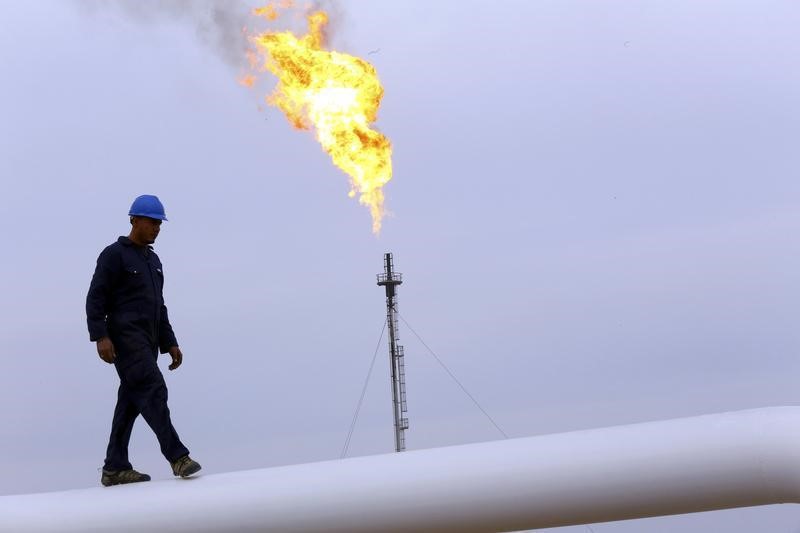By Barani Krishnan
Investing.com -- It was the sharpest U.S. crude draw in three weeks, yet it wasn’t enough to keep a barrel of the benchmark at above $80.
Recurring fears on Wall Street of a recession — reinforced by Bank of America’s intent to lay off 4,000 workers by June despite a sterling first quarter — and a reminder that the Federal Reserve will likely raise interest rates again in May despite easing inflationary pressure sealed oil bulls’ fate on Wednesday.
New York-traded West Texas Intermediate, or WTI, settled down $1.70, or 2.1%, at $79.16 a barrel, after a session low at $78.56.
The U.S. crude benchmark has lost 4% since the start of this week on recession and rate hike fears that extended the rebound in the dollar and U.S. Treasury yields from last week’s one-year lows.
"WTI crude is back below the $80 level and it could continue drifting lower if the strong dollar trade resumes," said Ed Moya, analyst at online trading platform OANDA.
WTI was also down possibly on technical reasons, as it attempts to fill its gap after producer group OPEC+ announced deeper production cuts to lift a market that hit 15-month lows in March.
“WTI reactivates a bearish scenario in continuation to fill out the run-away gap left at $75.70,” said Sunil Kumar Dixit, chief technical strategist at SKCharting.com. “This downward shift of momentum can extend to $74 after the gap is filled while this bearish phase is subject to prices holding below $81.50.”
London-traded Brent, the global benchmark for crude, settled down $1.65, or almost 2%, at $83.12. Like WTI, Brent was down nearly 4% on the week.
Bjarne Schieldrop, chief commodity analyst at SEB, said "darkening clouds on the macro-sky are concerning investors".
"There are significant weakening signals in global diesel demand along with falling manufacturing PMIs," said Schieldrop. "Historically, recessions lead to a cyclical trough in manufacturing activity, softer diesel demand and falling oil prices. So investors are cautious about buying into the bull-story based on OPEC cuts alone."
Stockpiles of crude oil in the United States fell last week at their largest pace in three weeks, reversing a build from the week prior, as refiners turned out more fuel for commercial vehicles, the Energy Information Information, or EIA, said in its Weekly Petroleum Status Report.
The crude balance in storage fell by 4.581 million barrels during the week ended April 14, EIA reported. In the previous week to April 7, crude stockpiles rose by 0.597M barrels.
Industry analysts tracked by Investing. com had expected the EIA to report a crude balance decline of just 1.088M barrels for last week.
The EIA said U.S. crude refinery inputs averaged 15.8M barrels per day during the week ended April 14 — some 260,000 barrels more a day than the average in the prior week to April 7.
Refineries operated at 91% of their operable capacity last week, the agency added. While production of gasoline for cars decreased last week, averaging 9.5M barrels daily, output of distillates for commercial vehicles rose, averaging 4.8M barrels per day.
The crude draw for last week registered despite the Biden administration pulling oil again from the nation's reserves in a bid to ease tight market supply that could lead to inordinately high fuel prices.
The administration released 1.6M barrels from the Strategic Petroleum Reserve, or SPR, last week, the EIA report showed. It was the third SPR draw for the year after a similar pull of 1.6M barrels during the prior week to April 7 and 3.7M in the week to March 31.
The Biden administration has leaned heavily on the SPR since late 2021 to offset tight crude supplies that had raised fuel costs for Americans. As of last week, the SPR's crude balance was at its lowest since November 1983.
Demand for finished fuel products was, however, lower last week, with an unexpected build in gasoline stockpiles and a smaller-than-expected draw in distillate inventories, the EIA report showed.
On the gasoline inventory front, the EIA cited a build of 1.3M barrels versus the forecast drop of 1.267M barrels, and against the previous weekly decline of 0.331M. Automotive fuel gasoline is the No. 1 U.S. fuel product.
In terms of product supplied to the market — a clear indicator of end-user demand — finished motor gasoline filled 8.519M barrels last week, down 416,000 barrels from the April 14 tally of 8.936M.
With distillate stockpiles, the EIA reported a 0.356M barrel draw, against expectations for a drop of 0.927M barrels and versus the prior week's consumption of 0.606M. Distillates are refined into heating oil, diesel for trucks, buses, trains and ships, and fuel for jets.
